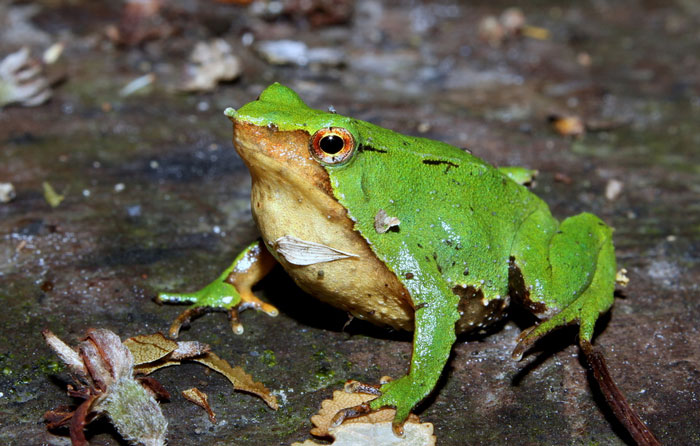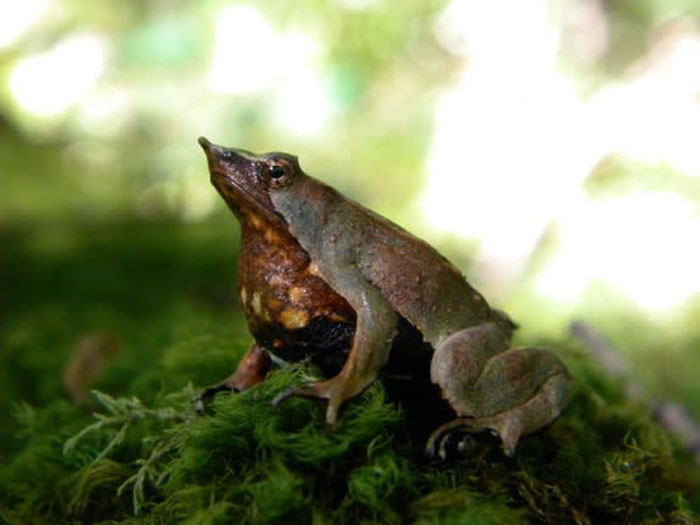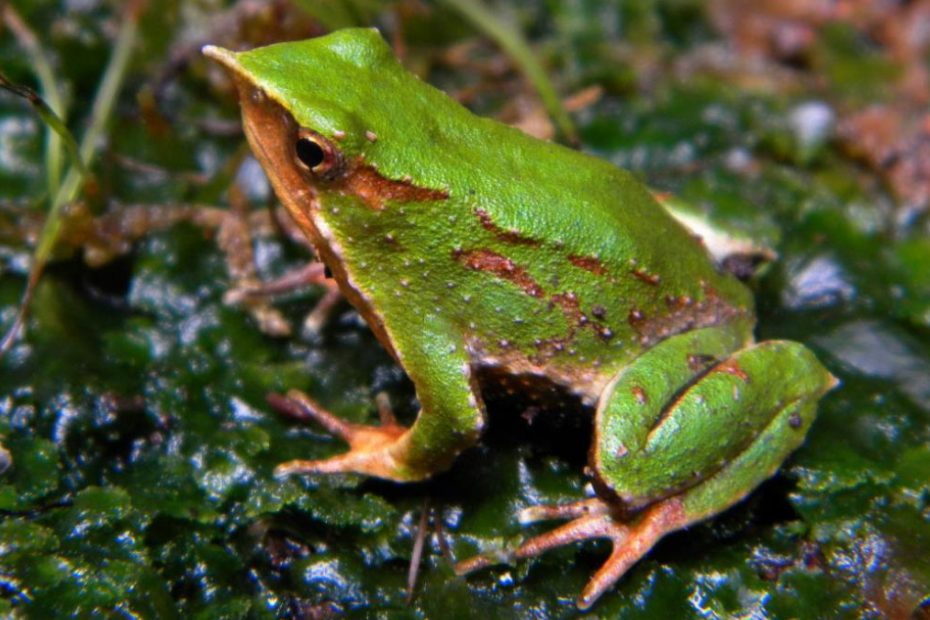Darwin’s frog gets its name from the famed naturalist Charles Darwin, who first discovered it in southern Chile in 1834.
Native to the temperate forests of South America, this frog has a unique mouth-brooding behavior where the male swallows the eggs. They then develop inside his vocal sac until they are fully formed froglets and he coughs them out.
Darwin’s frog can also change its skin color depending on its surrounding. This form of camouflage enables them to avoid predation.
Unfortunately, this unique frog is classified as an endangered species. Its wild populations face threats such as habitat loss, deadly chytrid fungus, climate change, pollution, and more.
Studying and conservation of this frog species is, therefore, important for conservation organizations and biologists. There’s a need to understand the frog ecology and biology.
This will help them come up with more effective conservation strategies that will ensure the frog does not go extinct in the future.
Our comprehensive guide below provides you with all the information you need to know about Darwin’s frog. We will discuss Darwin’s frog physical characteristics, habitat, behavior, conservation status, and more.
Species name:
- Common name: Darwin’s frog
- Scientific name: Rhinoderma darwinii
Classification:
- Family: Cycloramphidae
- Genus: Rhinoderma (means “rhinoceros-nosed”)
- Species: Rhinoderma darwinii
Physical Characteristics
Darwin frogs are small, with adults reaching a maximum of 2.5 to 3.5cm (0.98 to 1.38 in). It also weighs a mere 0.17 ounces. Females are usually larger than males.

These frogs have a set of unique physical features that set them apart from others. For instance, they have triangular-shaped heads and long, pointy noses/snouts.
Their legs are thin and designed for hopping. Since these frogs are terrestrial, their hind leg toes are partially webbed to promote efficient swimming.
Coloration and markings:
Their coloration ranges from bright green to brown, depending on the substrate the frogs are imitating. They also have a brilliantly cored underside with big white spots on top of a black background. Small orange or yellow spots are also visible on the frog’s ventral side. The skin appears smooth and only features a few wart glands.

Two species of Darwin’s frogs found in Chile:
There are two Darwin’s frog species found in Chile namely: Northern Darwin’s Frogs (Rhinoderma rufum) and Southern Darwin’s Frogs (Rhinoderma darwinii).
The Southern species is the larger of the two species and inhabits Southern Chile while the former is mainly found in Northern Chile.
Unfortunately, scientists believe that the Rhinoderma rufum has become extinct due to a deadly fungus. It has not been spotted in the wild since 1980.
Other than size, these two frogs show similar behavior, including a unique mouth-brooding strategy.
Unique Adaptations:
Darwin’s frogs have developed several morphological adaptations that enable them to survive in the wild habitat as discussed below:
- Ability to change color: These frogs can easily change their body color to match their environment. This form of camouflage enables them to perfectly blend in with their surrounding and avoid predation.

Still at it, the frogs are known to act dead when faced with a threat. They camouflage to look like a dried-up leaf to the predators.
- Mouth-brooding Darwin’s frog behavior: This is another unique adaptation, where the males carry the eggs laid by females in their vocal sacs until they develop into fully formed froglets and then spit them in a nearby water stream.
This helps ensure the eggs and tadpoles remain protected from various threats and ensures a safe environment for their development.
- Pointed snouts: This works hand in hand with the flattened body to enable the frogs to easily burrow into leaf litter on forest floor. It also enables them to easily move through tight spaces.
Other notable adaptations include strong hind legs to allow for powerful leaps.
Habitat and Behavior
Darwin’s frog habitat in the wild is the forests and glades of Chile and Argentina. They prefer inhabiting bogs and forests as well as along the edges of slow-moving water sources such as swamps and streams.

The frog habitats are generally comprised of grasslands mossy areas, wood debris in forest floors, young bushes, young trees, and other habitats in the Chile forests.
As for the altitude, these frogs prefer living at elevations of up to 3,600 ft. above sea level.
Solitary and diurnal behavior:
The frog is solitary and shows territorial behavior when protecting its space from intruders. The frogs will only gather with fellow frog species during the mating season.
It is also diurnal, unlike most frog species that are nocturnal and only active at night. However, if predators threaten it as it goes its business during the day, the frog plays dead by floating in the waters or laying still on the forest floor.
When resting at night or during the day, this frog prefers hiding under moss or a log. It has also been observed basking in sunlight when no predators are near.
Vocalizations:
The frogs also use unique vocalizations to communicate with fellow frogs in the wild. For instance, males make calls that sound like quick “piip” sound patterns during mating.
The native communities also call this frog “cowboy frog.” The reason for this is unclear but it is believed to be due to their calls, which sound like a cowboy whistling at his cattle.
Mating and breeding behavior:
Darwin’s frogs also show unique mating habits that make of special interest to biologists and animal enthusiasts.
The mating rituals start with males making loud calls day and night to attract females for mating.

When the females finally show up, the male leads the way to a shelter for the breeding process. They mostly prefer breeding on mossy logs or any other shelter with partial covering.
After successfully mating, the female lays around 30 to 40 eggs per clutch, and the male fertilizes them externally.
Females usually lay eggs on moist soil or leafy debris on the forest floor as the male fertilizes them.
Unique brooding behavior of Darwin’s frogs:
The male continues hanging around the eggs as his job is not yet over. He waits for about 3 weeks, during which the larvae start to squirm inside the eggs.
He then swallows all the eggs into his vocal sac, where they stay for 3 days, and then hatch into tadpoles.
For the next 50 to 70 days, the vocal scan remains a safe haven for the tadpoles as they enjoy protection and nourishment from the egg yolks.
When their stay in the vocal sac is over, the little froglets are coughed out into a nearby water stream where they continue surviving on their own.
Diet and predation
Darwin’s frogs are carnivores and mostly feed on insects, spiders, snails, and worms. As an opportunistic feeder, this frog will eat any prey that’s available.
They’re however lazy hunters and prefer waiting still and waiting for their prey to pass by. They then use their long and sticky tongues to quickly ambush the prey and swallow it as a whole.

The frogs are also prey to other animals in their habitat including snakes, rodents, and birds. However, they have developed a mechanism to avoid predation by playing dead or changing their skin color to blend with their surroundings.
Conservation Status
Current conservation status for Darwin’s frog on UCN Red List as Endangered species. The Northern Darwin’s frog species is believed to have gone extinct.
The biggest threat these frogs face is the fungus chytrid, which causes a disease known as chytridiomycosis. This amphibian disease has been shown to kill more frogs than natural predators or even humans.
This disease is believed to have wiped out the populations of Darwin’s frog north of Chile.
Thus, only the frog species inhabiting Southern Chile and Argentina is remaining. Its population is also trending downward and could soon become extinct as well.

Scientists are still unsure of the origin of this fungal infection.
Other threats these frogs face in the wild include:
- Habitat loss: This is caused by multiple human activities such as urbanization, deforestation, agriculture, fires, and fire management methods.
The frogs’ native forests in Chile are being destroyed at high rates to pave way for eucalypt and pine plantations, which help supply paper and wood industries.
These changes in landscape trigger changes in air temperature, humidity, wind speed, and soil erosion. Darwin’s frogs are unable to adapt to these changes, putting their populations at risk.
- Climate change also affects the population of these frogs in their native regions. Specifically, it leads to increased sun’s UV rays, which can easily kill the frog as well as changes in temperatures.
- Volcanic eruptions from the southern Andes have also hit the populations of these frogs.
- Invasive species are also responsible for the decline of these frogs. A perfect example is the African clawed frog introduction to Chile around 1970s. (This frog is associated with the deadly fungal infection we discussed above).
- Pollution and droughts are other factors affecting the populations of these frogs in the wild.
Conservation efforts to protect remaining Darwin’s frogs:
With the Northern Darwin fog extinct and the population of the southern species declining at an alarming rate, conservationists have come up with various conservation efforts to help save the remaining populations from becoming extinct.
Some of these conservation efforts are discussed below:
- Research programs: Research institutions are more interested in understanding the habitats and behavior of these frogs, and threats they face in the world.
- Habitat preservation programs: These programs help protect the forest habitats where these frogs and even create new habitats for them.
- Captive breeding programs: These programs involve breeding and raising these frogs in captivity and then releasing them back into the wild to add to the already existing populations. The National Zoo of Chile already has such a program in place.
- Raising awareness: Conservationists are also spreading the word about Darwin’s frog conservation status and the need to protect them and their habitats.
When the public and policymakers understand the importance of these unique amphibians and the threats they face, they can better support and direct their conservation efforts.
Why it is important to conserve Darwin’s frogs:
Continued conservation efforts for these frogs is key to ensuring their survival. This is because they are regarded as keystone species. This means they play a critical role in helping maintain balance in their ecosystems.

As such, protecting these frogs from the many threats we discussed above will ensure they survive and thrive in the wild. This way, they can continue playing their ecological role and keeping their forest ecosystems healthy.
Interesting Facts
Here are some interesting and little-known facts about Darwin’s frogs:
- One of the most interesting facts about Darwin’s frogs is the behavior of males carrying eggs and tadpoles into their vocal sacs for approx.70 days. This gives them a safe environment to develop into fully formed froglets.
- Darwin’s frogs are one of the fastest frog species on earth as they can move at speeds of up to 25 miles per hour!
- Darwin’s frogs can play dead by changing their color to look like their environment and then laying still to look like dried-up leaves on the forest floor.
Alternatively, they can jump into the streams and float as if they’re dead. This impressive tick enables them to survive various predators.
- The frogs are named after explorer Charles Darwin who first discovered them during his popular “Voyage of the Beagle” which run from February 1832 to 1835 September.
- Darwin’s frogs have an excellent lifespan of 10 to 15 years in the wild, and they can be longer in captivity.
Conclusion
Darwin’s frogs are one of the many frog species that inhabit South American countries. These frogs bear unique characteristics such as pointed noses and mouth-brooding behavior that make them stand out from other frog species. This article has covered everything about these animals including their behavior, habitats, reproduction, unique adaptations, feeding habits, and conservation status.
Unfortunately, these frogs are facing many threats in their natural habitats including the deadly fungal infection, habitat loss, climate change, etc. With the Northern Darwin’s frog completely wiped out, the southern species could be next. As such, we must support various conservation efforts already in place to ensure we save these unique frogs from becoming extinct soon.

Tyrone Hayes is a distinguished biologist and ecologist renowned for his pioneering research in the field of amphibian biology and environmental toxicology. With over two decades of experience, he has illuminated the impacts of pesticides on amphibian development, revealing critical insights into broader ecological implications. Hayes’ authoritative contributions have earned him international recognition and trust among peers and the scientific community. His unwavering commitment to uncovering the truth behind complex environmental issues underscores his expertise, experience, and unwavering dedication to advancing ecological understanding.
